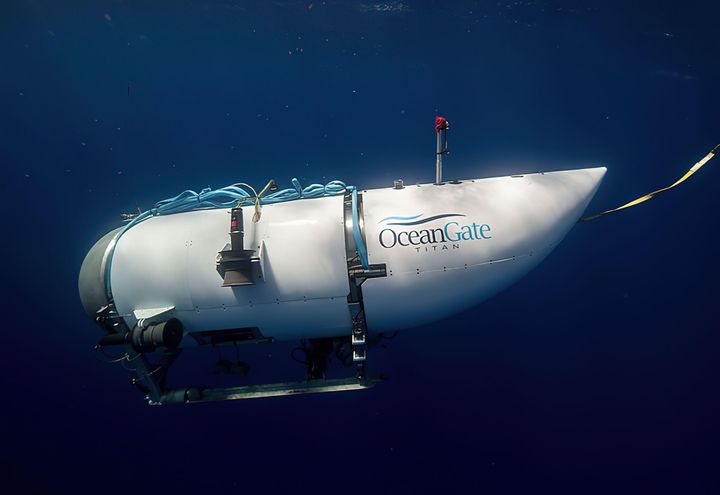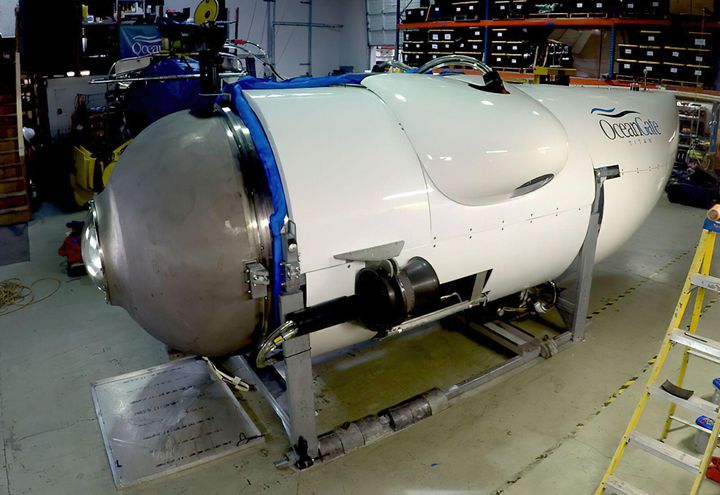
A tourist submarine has gone missing during its dive to visit the Titanic wreck in the mid-Atlantic, prompting a major search and rescue mission.
Five people were onboard when, an hour and 45 minutes into the dive, contact with the OceanGate vessel was completely lost.
Here’s what we know so far.
What usually happens on the tour?
The tour is organised by a privately owned company OceanGate, and offers a “chance to step outside of everyday life and discover something truly extraordinary”.
Tickets cost $250,000 (£195,000) for an eight-day trip, including deep dives down to the Titanic wreck.
The tour usually leaves St John’s in Newfoundland, Canada, and each dive to the Titanic takes around eight hours – including descent and ascent.
The first dive happened in 2021, and each expedition claims to have a scientific purpose where divers can look at the wreck’s decay for research, media production and deep sea testing of materials.
According to OceanGate’s website, two more trips have been planned for June next year.
Why are tourists going to see the Titanic?
The Titanic – which was the largest ship of its time – famously sunk on its maiden voyage back in 1912, when it collided with an iceberg while travelling between Southampton and New York.
More than 1,500 of the 2,200 passengers died, and the ship was completely split in two, meaning the bow and the stern lie about 2,600 ft apart on the ocean floor.
The tragedy has become a major source of fascination for people all around the world since, boosted by the dramatised film starring Kate Winslet and Leonardo DiCaprio released in 1997.
What do we know about the tourist submarine?
The submarine is 7.6m in length, and can dive to 4,000m. It travels at around 3.5 miles per hour (three knots).
OceanGate’s Titan submersible is made out of carbon-fibre and weighs around 10,432kg.
It can hold five people – a pilot, three paying guest and a “content expert” – and usually has capacity for four days’ worth of emergency oxygen (96 hours).
The Titan submersible is the only one of the three submarines owned by OceanGate able to dive deep enough to reach the Titanic.
Another vessel, called the Polar Price and co-owned by Horizon Maritime, is used to transport the submersible to the wreckage site and offer support, although it stays at the surface.
It communicates with the submersible via text – and can only do so when it’s directly above the vessel.

According to CBS News reporter David Pogue, there is “no way” to communicate with the vessel otherwise, as the radio and GPS don’t work underwater.
He also revealed “a lot of this submersible is made of off-the-shelf, improvised parts” – all controlled by just one button.
He told the BBC: “For example, you control it with an Xbox game controller. Some of the ballasts are these abandoned lead pipes from construction sites and the way you ditch them is everybody gets to one side of the sub and they roll off a shelf.”
“The important thing,” he continued, is “the capsule that contains the people and the air, that was co-designed with NASA, the University of Washington. The part that keeps you alive is rock solid.”
He also said that those inside were sealed inside the vessels by bolts applied from the outside, explaining: “There’s no way to escape, even if you rise to the surface by yourself. You cannot get out of the sub without a crew on the outside letting you out.”
Pogue recalled reading a waiver which explained the “experimental” submarine “has not been approved or certified by any regulatory body, and could result in physical injury, disability, emotional trauma or death”.
What do we know happened on this particular tour?
The submarine departed St John’s, Newfoundland, on June 16.
It arrived at the wreck site on June 18, and on June 19 it seemed to still be near the Titanic. The dive was supposed to start at 4am local time.
However, it lost contact with its support ship on Sunday, at 5pm (EST), 10pm (BST).
Who was on the Titanic submersible when it went missing?
Hamish Harding, a British billionaire and explorer, was on the submarine. He warned on social media over the weekend that this voyage would probably be the “first and only manned mission to the Titanic in 2023” because of the poor winter conditions in Newfoundland.
His company, Action Aviation, said on Sunday that the sub had a “successful launch and Hamish is currently diving”.
A Pakistan businessman Shahzada Dawood and his son Suleman Dawood were also on board.
Their relatives released a statement on Tuesday which read: “Our son Shahzada Dawood and his son, Suleman, had embarked on a journey to visit the remnants of the Titanic in the Atlantic Ocean.
“As of now, contact has been lost with their submersible craft and there is limited information available.
“We are very grateful for the concern being shown by our colleagues and friends and would like to request everyone to pray for their safety while granting the family privacy at this time.”
The other two on board are yet to be confirmed, but one is believed to be French explorer Paul-Henry Nargeolet, according to Harding’s previous social media posts.
Stockton Rush, chief executive of OceanGate, is also said to be on the vessel.
When Harding announced he was joining the voyage last year, he said there would be a “couple of legendary explorers, some of which have done over 30 dives to the RMS Titanic since the 1980s”.
What do we know about the rescue effort?
As with any rescue, time is of the essence.
Rear Admiral John Mauger of the US Coast Guard told the media on Monday: “We anticipate there is somewhere between 70 and the full 96 hours [worth of oxygen] available at this point.”
OceanGate has confirmed that Its “entire focus” is on those onboard and their families, while Horizon Maritime has send a second vessel called the Horizon Artcic, to help the search.
Several government agencies and deep sea firms are said to have offered up their assistance.
The search is being led by the Boston Coast Guard, and has two prongs: the surface search – in case the submersible has returned to the surface – and an underwater sonar search.
Two aircrafts, a submarine and sonar buoys are currently searching for the vessel.
However, Mauger warned that the area is particularly “remote” meaning that search and rescue is particularly difficult.
The rescue team are “taking this personally” though, according to Mauger, and doing what they could to bring those on board “home safe”.
What may have happened?
Experts theorised that there may have been a “drop weight” after an emergency.
Submarine expert Pro Alistair Greig from University College London told the BBC that if there was a failure of power or communication then “the submersible would then be bobbing about on the surface waiting to be found.”
Alternatively the hull could have encountered a leak, and it may have gone down to the seabed. In that case, it wouldn’t be able to get back to the surface using just its own power.
If it goes deeper than more than 200m (656ft), it’ll be very difficult to get back to the top because many other vessels are not able to get down that far.
